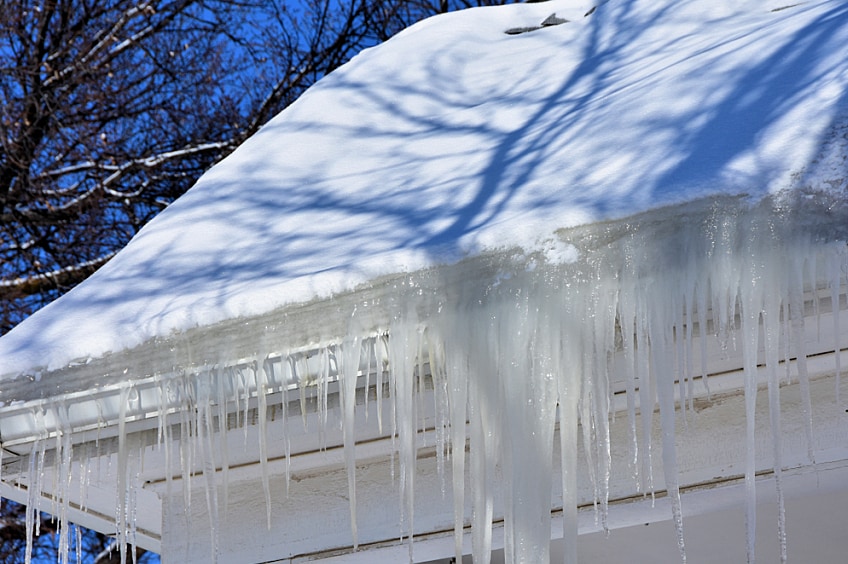When snow and ice are in the forecast, it makes sense to start thinking about safety precautions for your family. Those preparations extend to your home as well—the formation of ice dams on your roof can cause significant damage.
Before winter brings flurries of ice and snow your way, here's how ice dams form, what kind of damage they can cause in your home, and the best ways to approach ice dam prevention.
What Is an Ice Dam?
An ice dam is a mass of ice that forms along the bottom edge of the roof, often called the eave, where the roof extends past the exterior walls of your home. This mass of ice prevents water from draining off the roof and into the gutter system. Ice dams can be heavy, and they have the potential to cause structural damage to your home as well as damage your roofing system and gutters.
How Do Ice Dams Form?
Ice dams form when a roof's surface is unevenly heated. When conditions are right to create an ice dam, the upper part of the roof is warmed from the attic below, which causes snow to melt. This water then runs down to the roof edge—where the surface is cooler—and refreezes.
This creates the block of ice that prevents melting snow from draining to the gutter system. As runoff from melting snow continues to run down the roof, it can back up along the roof edge, causing further problems.
How Do Ice Dams Affect a House?
Once an ice dam forms, it prevents melting snow from running off the roof. Instead, that water pools in the lower section of your roof, eventually seeping under the roof shingles and soaking the roof deck, sheathing, and attic insulation. Leaks may continue into the attic space and through to the drywall in living areas.
Large ice dams are extremely heavy; they can cause damage to the structural integrity of the roof as well as the gutters. Heavy ice dams can also present a safety hazard to people walking below them.
4 Ice Dam Prevention Tips
1. Clean Your Gutters
Remove leaves and debris from your gutters before winter hits to prevent clogged gutters. Clogged gutters trap water and encourage ice dams to form.
2. Use a Roof Rake to Remove Snow
After a heavy snowfall, using a roof rake can help remove snow at the lower edge of the roof line for single-story homes. This helps prevent ice dams by removing snow before it melts. However, avoid going on the roof to remove snow—always access the roof from the ground. Use light pressure on the rake to avoid damaging any shingles.
3. Assess Your Attic Ventilation System
Ice dams stem from uneven roof heating, but the underlying problem is often improper attic ventilation. An effective attic ventilation system can help prevent uneven roof heating by keeping attic temperatures similar to the exterior ambient temperature. When attic temperatures are similar to the exterior temperature, there is a reduction in the freeze thaw cycle which often allows ice dams to form. Always ensure there is an adequate amount of attic ventilation for your home, consisting of both intake at or near the soffits and exhaust at or near the ridge. You can learn more about this at gaf.com/ventcalculator.
4. Call a Professional
Roofing contractors can help remove ice dams safely as well as ensure that your roof is ready for winter. These professionals use a steamer to melt the ice dam without damaging the roof. They can also assess your ventilation and insulation to help prevent ice from forming on your roof. In colder climates, local codes may even require a leak barrier product to be installed to help protect the roof deck from ice dam water infiltration.
As water backs up as a result of ice dams, the leaks they invite can cause serious damage. As long as your roof remains at freezing, all the snow will remain frozen. Removing the snow is the best way to prevent ice dams, but it must be done safely. If you have a multistory home or lack the proper tools to remove snow from your roof safely, consider calling a roofing professional to help, such as a contractor certified by GAF* in your area.
*Contractors enrolled in GAF certification programs are not employees or agents of GAF, and GAF does not control or otherwise supervise these independent businesses. Contractors may have agreed that they will use GAF roofing products, and may receive benefits, such as loyalty rewards points and discounts on marketing tools from GAF for participating in the program.

